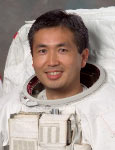
Lyndon B. Johnson Space Center
Houston, Texas 77058

 |
National
Aeronautics and Space Administration
Lyndon B. Johnson Space Center |
 |
Biographical Data |
||
Koichi Wakata (Ph.D.)
Astronaut, Japan Aerospace Exploration Agency (JAXA)
PERSONAL DATA: Born in 1963, in Saitama, Japan. Married and has one child. Enjoys flying, hang-gliding, baseball, tennis, and snow skiing.
EDUCATION: Graduated from Urawa High School, Saitama, in 1982; received a Bachelor of Science degree in Aeronautical Engineering in 1987, a Master of Science degree in Applied Mechanics in 1989, and a Doctorate in Aerospace Engineering in 2004, all from Kyushu University.
ORGANIZATIONS: Member of the Japan Society for Aeronautical and Space Sciences, the American Institute of Aeronautics and Astronautics, the Robotics Society of Japan, and the Japanese Society for Biological Sciences in Space.
SPECIAL HONORS: Minister of State for Science and Technology Commendation (1996). Special awards from Saitama Prefecture and Omiya City (1996). National Space Development Agency of Japan Outstanding Service Award (1996). Diplome pilote-cosmonaute de l' URSS V.M. Komarov (1997, 2001). NASA Exceptional Service Medal (2001). Japan Society for Biological Sciences in Space Distinguished Service Award (2001). Foreign Minister's Certificate of Commendation (2004).
EXPERIENCE: Dr. Wakata joined Japan Airlines (JAL) in April 1989. He was assigned to the Base Maintenance Department, Narita, Chiba, where he was designated as a structural engineer. From July 1991 to May 1992, he was assigned to the Airframe Group, Systems Engineering Office, Engineering Department of JAL. During his tenure with JAL, Dr. Wakata was involved in multiple research and engineering projects in the fields of structural integrity of transport aircraft, fatigue fracture, corrosion prevention, and the environmental effects on fuselage polished aluminum skin on B-747 aircraft. He was selected as an astronaut candidate by the National Space Development Agency of Japan (NASDA) in June 1992. A multi-engine and instrument rated pilot, Dr. Wakata has logged over 2100 hours in a variety of aircraft.
NASA/JAXA EXPERIENCE: Dr. Wakata reported to the Johnson Space Center in August 1992. He completed one year of training and was qualified for assignment as a Mission Specialist on the Space Shuttle. Dr. Wakata's technical assignments to date include: payload science support for the Astronaut Office Mission Development Branch (April 1993 to February 1995), Space Shuttle flight software verification testing in the Shuttle Avionics Integration Laboratory (SAIL) (April to October 1994), Space Shuttle and Space Station Robotics for the Astronaut Office Robotics Branch (March 1996 to July 2006), and Extravehicular Activities (EVA) development for the Astronaut Office EVA Branch (May 2001 to April 2006). During the STS-85 mission (August 7-19, 1997), Dr. Wakata was the NASDA Assistant Payload Operations Director for the Manipulator Flight Demonstration, a robotic arm experiment for the Japanese Experiment Module of the International Space Station (ISS). He operated the robotic arm system on NASDA’s Engineering Test Satellite VII in the tele-operation robotics experiments in 1999. Since December 2000, he has been a NASA robotics instructor astronaut. Dr. Wakata commenced training for a long-duration expedition on the ISS in October 2001. In July 2006, he served as the commander of the 10th NASA Extreme Environment Mission Operations (NEEMO) mission, a seven-day undersea expedition at the National Oceanic & Atmospheric Administration’s Aquarius habitat located off the coast of Florida. In August 2006, he started flight engineer training for Russian Soyuz spacecraft. In February 2007, Dr. Wakata was assigned as a flight engineer to ISS Expedition 18. On March 15, 2009 he launched with the crew of STS-119 and became the first resident station crew member from the Japanese Aerospace Exploration Agency (JAXA). He will return to Earth in June 2009 with the crew of STS-127.
SPACE FLIGHT EXPERIENCE: STS-72, Endeavour (January 11-20, 1996): Dr. Wakata flew as the first Japanese Mission Specialist on this 9-day mission during which the six-member crew retrieved the Space Flyer Unit (launched from Japan ten months earlier), deployed and retrieved the OAST-Flyer, and conducted two spacewalks to demonstrate and evaluate techniques to be used in the assembly of the International Space Station. The STS-72 mission was completed in 142 orbits, traveling 3.7 million miles in 8 days, 22 hours, and 40 seconds.
STS-92, Discovery (October 11-24, 2000): Dr. Wakata became the first Japanese astronaut to work on the ISS assembly on this 13-day mission during which the seven-member crew attached the Z1 Truss and Pressurized Mating Adapter 3 to the ISS using Discovery’s robotic arm and performed four space walks to configure these elements. This expansion of the ISS opened the door for future assembly missions and prepared the station for its first resident crew. The STS-92 mission was accomplished in 202 orbits, traveling 5.3 million miles in 12 days, 21 hours, 40 minutes, and 25 seconds.
Dr. Wakata has logged a total of 21 days, 19 hours, 41 minutes, and 5 seconds in space.
MAY 2009